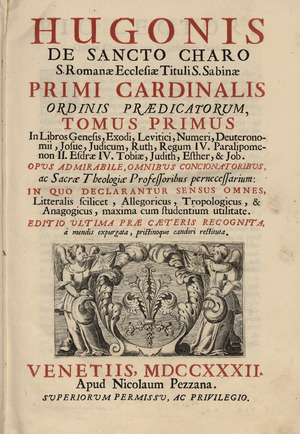Hugh of Saint-Cher facts for kids
Quick facts for kids His Eminence Hugh of Saint-Cher O.P. |
|
|---|---|
| Cardinal Priest of Santa Sabina (1244–1261) Cardinal Bishop of Ostia (1261–1262) Cardinal Priest of Santa Sabina (1262–1263) |
|
 |
|
| Province | Rome |
| See | Bishop of Ostia |
| Enthroned | 1261 |
| Reign ended | 1262 |
| Predecessor | Rinaldo di Jenne |
| Successor | Henry of Segusio |
| Orders | |
| Ordination | c. 1227 |
| Consecration | 1261 |
| Created Cardinal | 1244 |
| Personal details | |
| Born | c. 1200 Saint-Cher, Dauphiné |
| Died | 19 March 1263 Orvieto, Papal States |
| Nationality | Dauphinois |
| Denomination | Roman Catholic |
Hugh of Saint-Cher (born around 1200, died March 19, 1263) was a French friar from the Dominican Order. He became a very important leader in the Catholic Church as a cardinal. Hugh was also well-known for his writings and comments on the Bible.
Contents
Early Life and Studies
Hugh was born in a place called Saint-Cher, near Vienne in France, around the year 1200. When he was about 14, he went to the University of Paris. There, he studied many subjects like philosophy, theology (the study of religion), and jurisprudence (the study of law). He even taught law at the university later on.
In 1225, Hugh joined the Dominican Order, which was a new group of friars at the time. He quickly became an important leader in the Order. He was chosen as the head of the Dominicans in France. In 1230, he became a Master of Theology and the head of the Dominican monastery in Paris.
Hugh helped the Dominican Order grow a lot. He also gained the trust of Pope Gregory IX. The Pope even sent him on an important mission to Constantinople in 1233.
Becoming a Cardinal
In 1244, Pope Innocent IV made Hugh a Cardinal Priest. This was a very high position in the Church. Hugh was the first Dominican friar to become a cardinal. His main church as a cardinal was Santa Sabina in Rome, which was also the main church for the Dominican Order.
Hugh played a big part in the First Council of Lyons in 1245. This was an important meeting of Church leaders. He also helped to start the Feast of Corpus Christi, a special day of celebration in the Church calendar.
In 1247, Pope Innocent IV asked Hugh to review the rules for another religious group called the Carmelites. These rules were very strict, and the Pope wanted them to be easier to follow in Europe. Hugh made some changes, and these new rules are still used by the Carmelite Order today.
After the death of Holy Roman Emperor Frederick II in 1250, Pope Innocent sent Hugh to Germany. His job was to help choose the next emperor.
Dealing with New Ideas
Under Pope Alexander IV, Hugh oversaw groups that looked into new ideas. In 1255, he helped to condemn a book called Introductorius in Evangelium aeternum. This book promoted ideas from a person named Joachim of Fiore. These ideas were causing worry among Church leaders.
Hugh also supervised the condemnation of another work called De periculis novissimorum temporum. This book criticized the new religious orders, like the Dominicans and Franciscans. These orders were becoming very popular in universities, which upset the older, traditional clergy.
From 1256 to 1262, Hugh served as the Major Penitentiary of the Catholic Church. This meant he was in charge of forgiving sins and giving out special permissions. In December 1261, he was named Cardinal Bishop of Ostia, another high rank. However, he resigned a few months later and returned to his previous title at Santa Sabina.
Hugh of Saint-Cher died on March 19, 1263, in Orvieto, Italy. He was living there with Pope Urban IV at the time.
Hugh's Important Works
Hugh of Saint-Cher, or perhaps a team working with him, created the first "correctorium" of the Bible. This was a collection of different versions and readings of the Bible text. His work was called "Correctio Biblie."
In his "Correctio Biblie," Hugh explained that he compared many Latin versions of the Bible. He also looked at Hebrew manuscripts. This careful approach to the Bible text was quite new for his time.
Hugh also wrote a commentary on a famous theological book called Book of Sentences by Peter Lombard. This commentary was very important for later theologians. It introduced new ways of thinking about God's power.
Another important work by Hugh was the Postillae in sacram scripturam. This book offered detailed comments on the Bible, looking at its literal meaning and deeper spiritual meanings. His writings on the Bible were published in many volumes in the 18th century.
Hugh also led the creation of the first Bible concordance. A concordance is a list of all the words in the Bible, showing where they appear. This huge project was finished in 1230 and helped many people study the Bible.
Images for kids



